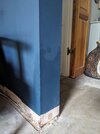- Joined
- 23 Feb 2017
- Messages
- 112
- Reaction score
- 4
- Country

I can't work this out but we seem to have what seems to be damp on an internal wall corner between our living room and dining room. It's no where else in the house so I can't work out why there would be damp here. The wall used to divide two rooms but in the past was knocked through to open up the space. The plaster below it (not painted) where skirting was doesn't feel damp to touch though
Is this damp or could it be something else?
Is this damp or could it be something else?

